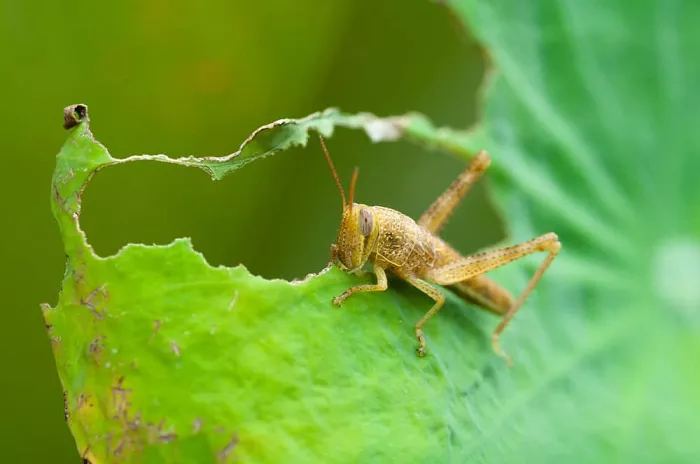Grasshoppers are common garden visitors, but their feeding habits can sometimes cause concern for gardeners. Understanding which plants they prefer can help us manage their presence and protect our beloved gardens. In this article, we will explore the diet of grasshoppers and provide practical tips for gardeners.
Grasshoppers’ Favorite Plants
Grasshoppers are known for their voracious appetites, and their diet is surprisingly diverse. They primarily feed on plants, with a particular preference for certain types. Let’s dive into the specifics.
Grasses and Cereals
Grasshoppers have a natural affinity for grasses. These insects thrive on the tender leaves and stems of various grass species. For example, they are often found in fields of wheat, corn, and barley. The lush green blades provide both nutrition and a suitable habitat. In agricultural settings, this can lead to significant crop damage if left unchecked.
Leafy Vegetables
Leafy greens are another favorite on the grasshopper menu. Vegetables like lettuce, spinach, and kale are particularly appealing. Their soft leaves are easy for grasshoppers to chew and digest. Gardeners growing these crops may notice holes and chewed edges on the leaves, a clear sign of grasshopper activity.
Herbs and Flowers
Grasshoppers do not discriminate when it comes to herbs and flowers. Many gardeners are dismayed to find their basil, parsley, and dill plants being nibbled on. Flowers like marigolds, zinnias, and cosmos are also at risk. The bright petals and soft leaves of these plants are irresistible to grasshoppers.
Weeds and Wild Plants
In addition to cultivated plants, grasshoppers also feed on weeds and wild plants. Dandelions, clover, and plantain are common targets. These plants often grow in abundance in natural environments and provide a steady food source for grasshoppers. Their ability to thrive on a variety of plants is one reason grasshoppers are so widespread.
Factors Influencing Grasshopper Feeding Habits
Several factors influence what grasshoppers choose to eat. Understanding these can help gardeners anticipate and manage potential problems.
Nutritional Needs
Grasshoppers require a balanced diet to support their growth and reproduction. They seek out plants that provide essential nutrients such as carbohydrates, proteins, and vitamins. This is why they are attracted to both grasses and leafy vegetables, which offer a mix of these nutrients.
Environmental Conditions
Environmental conditions play a crucial role in determining grasshopper feeding habits. In hot and dry weather, they may prefer plants with higher water content. During periods of drought, they might turn to succulent plants or those with thick leaves that store water.
Plant Availability
The availability of plants in a given area also affects what grasshoppers eat. In a garden with a wide variety of plants, they may sample different species. However, if certain plants are more abundant, they will focus on those. This is why monoculture crops are particularly vulnerable to grasshopper infestations.
Managing Grasshoppers in the Garden
While grasshoppers are a natural part of the ecosystem, their feeding habits can be problematic for gardeners. Here are some strategies to manage their presence.
Physical Barriers
One effective method is to use physical barriers such as row covers or netting. These can protect vulnerable plants from grasshopper damage. By creating a barrier, you can prevent grasshoppers from reaching the plants they love to eat.
Natural Predators
Encouraging natural predators is another approach. Birds, spiders, and certain insects prey on grasshoppers. By creating a garden environment that supports these predators, you can help keep grasshopper populations in check.
Plant Selection
Choosing plants that are less attractive to grasshoppers can also be beneficial. Some plants, like lavender and rosemary, are less appealing due to their strong scents. Incorporating these into your garden can help deter grasshoppers.
Chemical Controls
In severe cases, chemical controls may be necessary. However, it is important to use these sparingly and follow the instructions carefully. Many chemical pesticides can also harm beneficial insects and other wildlife.
The Role of Grasshoppers in the Ecosystem
Despite their potential to cause damage, grasshoppers play an important role in the ecosystem. They are a food source for many animals and contribute to nutrient cycling. Their feeding habits help break down plant material, returning nutrients to the soil.
Benefits for Wildlife
Grasshoppers are an essential part of the food chain. They provide sustenance for birds, reptiles, and small mammals. By supporting a diverse range of wildlife, grasshoppers contribute to a healthy and balanced ecosystem.
Contribution to Soil Health
The process of feeding and excreting also benefits the soil. Grasshopper droppings add organic matter, which improves soil structure and fertility. This natural cycle is an important part of maintaining a healthy garden environment.
Conclusion
Grasshoppers are fascinating creatures with a diverse diet. While they can be a challenge for gardeners, understanding their feeding habits can help us manage their presence. By using a combination of strategies, we can protect our plants and still appreciate the role grasshoppers play in the ecosystem. With a balanced approach, our gardens can thrive alongside these natural inhabitants.


